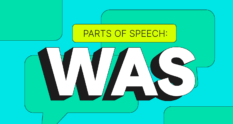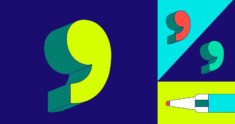
English pronunciation of words isn’t always intuitive. The same letter combinations in one word may make a completely different sound in another. One way to practice your pronunciation is by breaking words down into syllables. Syllables are the sonic units of a word, sometimes called the “beats” of a word.
We do this naturally when we speak. Every time you say a new syllable, your mouth has to change its shape and make a new sound. Noticing when this happens and counting syllables can help you break words down into recognizable patterns that are easier to pronounce.
What is a syllable?
A syllable is an unbroken vowel sound within a word. Notice that we say a vowel sound, not just a vowel by itself. A vowel sound contains whichever consonants (and other vowels) are attached to a vowel to make a certain, distinct sound.
For example, the word blanket has two syllables: blan + ket. The syllables are formed around the ay sound from the a and around the eh sound from the e.
However, simply counting vowels won’t always give you the number of syllables in a word. Sometimes vowels are silent, like in the word grape. Grape has two vowels but only one syllable.
Sometimes two vowels combine to make a single sound; this is called a diphthong. For example, the vowels o + u make an ow sound. The word proud has two vowels but only one syllable.
How do you count syllables?
There are different ways to figure out how many syllables a word has. Some of these techniques will come naturally to you, and others may not be as comfortable. Try out a few and see which you like best.
Chin method
Your chin is an excellent syllable counter. Place your hand underneath your chin and say a word out loud. Each time your chin pushes down into your hand, you count one syllable. You may have to exaggerate your pronunciation because some sounds don’t cause a big chin movement. The word drop will cause a big drop, but the word beat will yield a more subtle one. (Note: Both of these words are monosyllabic, or words with only one syllable. You will only feel your chin hit your hand once.)
Clap method
For the clap method, say a word out loud and clap every time you hear a vowel sound. Don’t think too hard; just clap whenever you think the sound is changing.
Listen method
Once you begin to recognize what a syllable is, you won’t need to break into applause to read a paragraph anymore. The listen method is simple: Listen for new vowel sounds. Each new vowel sound is a new syllable.
Written method
If you’re more of a visual learner, the written method might be for you. First, count all of the vowels in the word. Then:
- Subtract 1 for every pair of vowels that makes a sound together (for example: oo, ie, ou, au).
- Subtract 1 for every silent vowel (like an ‘e’ at the end of a word)
Example: The word universe
First, count the vowels: u, i, e, and e. There are 4.
The e at the end is silent, so subtract one. Now there are 3.
There are no vowel pairs, so we’re done! The word universe has 3 syllables.
All of these rules have exceptions, but they are a good way to get started until counting syllables comes naturally to you.
Advice about extra-long words
If you encounter a long or complicated word on the page, one way you can learn its pronunciation is by reading it in reverse. This might sound more confusing at first, but if you can count syllables, then you can use this trick.
For example, let’s break down the word monosyllabic.
If we try to plow through it from beginning to end, it might come out as a mishmash of m’s, s’s, and b’s.
Now try practicing the pronunciation backward, adding one syllable at a time:
bic la-bic syl-la-bic mon-o-syl-la-bic
It takes a bit longer to learn words this way, so this is a practical method only for particularly long or complicated words.
Another trick is to learn common prefixes and suffixes. These will almost always stand out as separate syllables.
What are the different types of syllables?
Learning how to recognize and count syllables will give your pronunciation a big boost. If you’re curious and want to dig a little deeper, there are six different types of syllables:
1 Closed syllables: A closed syllable has one vowel sound and ends with a consonant.
Examples: stop, fort, sell, book, smart.
2 Open syllables: An open syllable is a unit that ends in a vowel sound.
Examples: boba tea, fly, tree, velcro.
3 Vowel-consonant-e syllables (VCE): These syllables end in a silent e, which is why they are sometimes called “magic-e” syllables. The silent e gives the vowel before it a long sound (it sounds like you are saying the vowel instead of pronouncing it).
Examples: care, fire, mine, more.
4 R-controlled syllables (VR): R-controlled syllables contain a vowel followed by the letter r.
Examples: blur, ear, sir, for.
5 Diphthong syllables: Diphthongs are a “vowel team,” or a pair of vowels that work together to create a single sound. Common English diphthongs are oi, ou, and ea.
Examples: point, house, break, beat.
6 Consonant le syllables: This syllable has a sneaky vowel (just like the vowel-consonant-e syllables above). It is, again, a silent e. The consonant le syllable specifically describes words that end in le because you will not actually hear the vowel sound; you will only hear and pronounce an l.
Examples: bicycle, file, circle, example.
Syllable FAQs
What is a syllable?
A syllable is a vowel-sound unit in a word. Learning how to identify and count syllables is a good way to learn English pronunciation.
What are the different kinds of syllables?
Syllables are categorized by which letters they use and which sounds they make as a result. There are six types of syllables: closed, open, vowel-consonant-e, r-controlled, diphthong, and consonant le syllables.
How do you count syllables?
There are a variety of ways to count syllables. The most common methods are the chin method and the clap method. More advanced counters can use the listen method or the written method.






